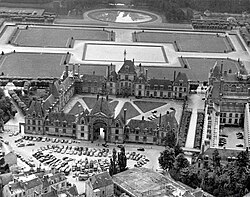| No. | Portrait | Name | Title | Took office | Left office | Time in office | Country |
|---|
| 1 | | Juin, Alphonse Alphonse Juin
(1888–1967) | Commander in Chief, Allied Forces Central Europe | 20 August 1953 | September 1956 | 3 years |  France France |
| 2 | | Valluy, Jean-Etienne Jean Étienne Valluy
(1899–1970) | Commander in Chief, Allied Forces Central Europe | October 1956 | May 1960 | 3 years, 7 months |  France France |
| 3 | | Challe, Maurice Maurice Challe
(1905–1979) | Commander in Chief, Allied Forces Central Europe | May 1960 | February 1961 | 9 months |  France France |
| 4 | | Jacquot, Pierre Pierre-Elie Jacquot [ fr ]
(1902–1984) | Commander in Chief, Allied Forces Central Europe | March 1961 | December 1963 | 2 years, 10 months |  France France |
| 5 | | Crépin, JeanJean Albert Emile Crépin
[a] | Commander in Chief, Allied Forces Central Europe | December 1963 | June 1966 | 2 years, 6 months |  France France |
| 6 | | Kielmansegg, Johann Johann Adolf Graf von Kielmansegg
(1906–2006) | Commander in Chief, Allied Forces Central Europe | 15 March 1967 | 1 April 1968 | 1 year |  Germany Germany |
| 7 | | Bennecke, Jürgen Jürgen Bennecke [ de ]
(1912–2002) | Commander in Chief, Allied Forces Central Europe | 1 July 1968 | 30 September 1973 | 5 years, 2 months |  Germany Germany |
| 8 | | Ferber, Ernst Ernst Ferber [ de ]
(1914–1998) | Commander in Chief, Allied Forces Central Europe | 1 October 1973 | 30 September 1975 | 1 year, 11 months |  Germany Germany |
| 9 | | Schnell, Karl Karl Schnell [ de ]
(1916–2008) | Commander in Chief, Allied Forces Central Europe | 1 October 1975 | 7 January 1977 | 1 year, 3 months |  Germany Germany |
| 10 | | Schulze, Franz Franz-Joseph Schulze
(1918–2005) | Commander in Chief, Allied Forces Central Europe | 7 January 1977 | 30 September 1979 | 2 years, 8 months |  Germany Germany |
| 11 | | Senger, Ferdinand Ferdinand von Senger und Etterlin
(1923–1987) | Commander in Chief, Allied Forces Central Europe | 1 October 1979 | 28 September 1983 | 3 years, 11 months |  Germany Germany |
| 12 | | Chalupa, Leopold Leopold Chalupa [ de ]
(1927–2021) | Commander in Chief, Allied Forces Central Europe | 28 September 1983 | 1 October 1987 | 4 years |  Germany Germany |
| 13 | | Sandrart, Hans Hans-Henning von Sandrart [ de ]
(1933–2013) | Commander in Chief, Allied Forces Central Europe | 1 October 1987 | 27 September 1991 | 3 years, 11 months |  Germany Germany |
| 14 | | Ondarza, Henning Henning von Ondarza [ de ]
(born 1933) | Commander in Chief, Allied Forces Central Europe | 27 September 1991 | 23 March 1994 | 2 years, 5 months |  Germany Germany |
| 15 | | Hansen, Helge Helge Hansen
(born 1936) | Commander in Chief, Allied Forces Central Europe | 1 April 1994 | March 1996 | 1 year, 11 months |  Germany Germany |
| 16 | | Stöckmann, Dieter Dieter Stöckmann
(born 1941) | Commander in Chief, Allied Forces Central Europe | March 1996 | 30 March 1998 | 2 years |  Germany Germany |
| 17 | | Spiering, Joachim Joachim Spiering [ de ]
(1940–2023)
[b] | Commander in Chief Allied Forces North Europe | 30 March 1998 | March 2001 | 2 years, 11 months |  Germany Germany |
| 18 | | Deverell, JackSir Jack Deverell
(born 1945) | Commander in Chief Allied Forces North Europe | March 2001 | January 2004 | 2 years, 10 months |  United Kingdom United Kingdom |
| 19 | | Back, Gerhard Gerhard W. Back [ de ]
(born 1944)
[c] | Allied Joint Force Command Brunssum | January 2004 | 26 January 2007 | 3 years |  Germany Germany |
| 20 | | Ramms, Egon Egon Ramms
(born 1948) | Allied Joint Force Command Brunssum | 26 January 2007 | 29 September 2010 | 3 years, 8 months |  Germany Germany |
| 21 | | Langheld, Wolf Wolf-Dieter Langheld [ de ]
(born 1950) | Allied Joint Force Command Brunssum | 29 September 2010 | 14 December 2012 | 2 years, 2 months |  Germany Germany |
| 22 | | Domröse, Hans Hans-Lothar Domröse
(born 1952) | Allied Joint Force Command Brunssum | 14 December 2012 | 3 March 2016 | 3 years, 2 months |  Germany Germany |
| 23 | | Farina, Salvatore Salvatore Farina
(born 1957) | Allied Joint Force Command Brunssum | 4 March 2016 | 16 February 2018 | 1 year, 11 months |  Italy Italy |
| 24 | | Riccardo Marchiò Riccardo Marchiò
(born 1955) | Allied Joint Force Command Brunssum | 16 February 2018 | 31 March 2019 | 7 years, 5 months |  Italy Italy |
| 25 | | Buhler, Erhard Erhard Bühler
(born 1956) | Allied Joint Force Command Brunssum | 31 March 2019 | 22 April 2020 | 1 year |  Germany Germany |
| 26 | | Vollmer, Jörg Jörg Vollmer
(born 1957) | Allied Joint Force Command Brunssum | 22 April 2020 | 3 June 2022 | 2 years, 1 month |  Germany Germany |
| 27 | | Miglietta, Guglielmo Luigi Guglielmo Miglietta [ de ]
(born 1961) | Allied Joint Force Command Brunssum | 3 June 2022 | 11 June 2025 | 3 years |  Italy Italy |
| 28 | | Gerhartz, Ingo Ingo Gerhartz
(born 1965)
[25] | Allied Joint Force Command Brunssum | 11 June 2025 | Incumbent | 1 month |  Germany Germany |




























